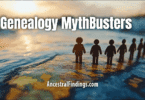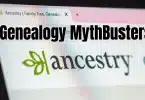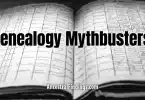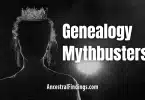Many of us grow up hearing stories about our family’s background. Maybe your grandmother insisted her side of the family was “pure Irish.” Or perhaps your grandfather proudly declared that his ancestors were “completely German, no mixture at all.” In some households, there is even the belief that one particular ancestor was “full-blooded Cherokee,” “100 percent Scottish,” or “pure Italian.”
These stories are often told with pride. They give families a sense of identity and belonging. But when we hold them up to the light of history and genealogy, a different picture emerges. The idea that an ancestor was “100 percent” one ethnicity is rarely true, and it is almost never as simple as the stories make it sound.
The myth of pure ethnicity is powerful because it speaks to human longing. People like neat boxes and clear categories. We want to know where we come from. We want to say, with confidence, “My ancestors were entirely Irish,” or “We have nothing but German blood.” The problem is, history is messy, borders change, and people have always moved, married, and mixed.
This time, we are going to explore why the myth of pure ethnicity exists, where it came from, how DNA testing complicates it, and what the records really show. By the end, you’ll see that your ancestors, like everyone else’s, were part of a long story of blending, migration, and mixing. And that makes your family history far more interesting than the myth of “100 percent” purity.
Why the Myth of Pure Ethnicity Exists
To understand why people cling to the idea of pure ancestry, we need to look at history and culture. In many immigrant families, ethnicity was a way of holding on to identity. When Irish immigrants came to America in the 19th century, they often emphasized their “Irishness” as a badge of pride in the face of discrimination. Germans, Italians, Poles, and countless other groups did the same. Over time, those identities became shorthand in families: “We are Irish” or “We are German.”
Nationalism also played a role. In the 19th and 20th centuries, many countries emphasized national pride, sometimes to the point of claiming ethnic purity. That idea filtered into family stories. A person from Poland might have described themselves as purely Polish, even though their ancestors lived in regions that had been German, Austrian, or Russian at different times.
There is also the natural human desire for simplicity. It’s easier to say “100 percent Italian” than to explain that your ancestor came from a border region where people intermarried with Austrians, Croatians, and Hungarians. Family stories trim the complexity away, leaving a simple, repeatable phrase.
And finally, the myth often grows stronger with each generation. A grandparent might have had some sense of mixed background, but by the time the story is passed to the grandchildren, the details are lost, and only the proud declaration remains: “We are pure Irish.”
The Messy Reality of Borders and Migration
History does not support the idea of purity. Europe, Africa, Asia, and the Americas were never static. Borders shifted constantly. Wars, treaties, and migrations redrew maps over and over again.
Take Germany as an example. The modern nation of Germany did not even exist until 1871. Before that, it was a patchwork of kingdoms, duchies, and free cities. Someone who lived in Prussia in 1820 might be called German, but their ancestors may have come from Poland or Bohemia. Their “German” identity was as much about politics as it was about blood.
The same is true of Ireland. Many families who call themselves “pure Irish” have Scottish ancestors who came to Ulster during the Plantation of Ireland in the 17th century. Some of those families later emigrated to America, calling themselves Irish, even though their roots were both Irish and Scottish.
Eastern Europe is an even bigger tangle. Poles, Ukrainians, Lithuanians, Russians, and Jews lived side by side for centuries, often intermarrying. When borders shifted, people suddenly found themselves counted as citizens of another country, even though their family had never moved. A “100 percent Polish” ancestor may have had grandparents who were German-speaking Silesians or Jewish merchants from Galicia.
And of course, migration has always been part of the human story. Italians moved north into Switzerland, Jews moved across Europe, Africans were forced into the Americas through the transatlantic slave trade, and Native tribes in North America often absorbed outsiders into their communities. The mixing was constant.
DNA Testing and the Illusion of Precision
Modern DNA testing has made the myth of pure ancestry even trickier. Companies like AncestryDNA, 23andMe, and MyHeritage present results in percentages. You might see a pie chart that says you are 45 percent Irish, 30 percent English, 15 percent German, and 10 percent Scandinavian. These results can be fascinating, but they are not as precise as they look.
DNA ethnicity estimates are based on comparing your DNA to reference panels of people living in certain regions today. The problem is that those regions overlap. People in northern France and southern England share many genetic markers. Germans and Poles often look genetically similar because their populations have mixed for centuries.
This means that if a test says your ancestor was 100 percent Irish, what it really means is that their DNA looked most similar to today’s Irish reference panel. It does not mean they had no English, Scottish, or Viking ancestors. It just means the test could not distinguish those older mixtures clearly.
Another complication is that DNA results change over time. As companies update their reference panels, your percentages may shift. One year you might be 20 percent Scandinavian, the next year you might be 5 percent. That does not mean your ancestors changed. It means the science improved.
So when a family clings to the idea of a pure ancestor, DNA does not back it up. Instead, it shows how blended everyone’s background really is.
Real-World Examples of Mixed Ancestry
Stories from actual research drive the point home.
One family believed their ancestor was purely Italian, from a village in Sicily. Records confirmed he was born there, but when baptismal registers were examined, his mother turned out to be Maltese, and his grandmother came from Tunisia. That “100 percent Italian” ancestor was in fact a mix of Mediterranean identities.
Another family insisted their great-grandmother was full-blooded Cherokee. Census records from the early 20th century listed her as white. When her parents’ marriage record was found, both were identified as of European descent. Later DNA testing of her descendants showed a small percentage of Native ancestry, but not a full line. The family story exaggerated the truth.
Yet another researcher traced a line back to Ireland. The story was that the family had always been Irish. But land records from the 1600s showed that their ancestors came from Scotland during the Ulster Plantation. Over time, the family merged into Irish culture and thought of themselves as Irish. Their descendants carried on the story of being “pure Irish,” but the reality was a blend of Scottish and Irish heritage.
How to Research Ethnicity the Right Way
If we cannot trust the myth of purity, what should genealogists do? The answer is to focus on records and context rather than on simple labels.
Start with vital records: birth, marriage, and death certificates. These sometimes list places of origin, languages spoken, or religious affiliations. Next, look at church records. Baptisms, confirmations, and burials often record not just names and dates but also sponsors and godparents, who can hint at ethnic communities.
Census records can also provide clues. In some years, they recorded mother tongue or place of birth for both the person and their parents. Naturalization papers are especially valuable, since they list places of origin.
Don’t forget local histories and newspapers. Many immigrant communities published in their native language, leaving behind valuable cultural clues.
Finally, use DNA wisely. Do not treat percentages as absolutes. Use them as hints to guide your document research. If DNA suggests Scandinavian ancestry, look for migration patterns in your family’s region that might explain it.
Why Mixed Heritage is Better than the Myth
Here’s the surprising part: once you let go of the idea of pure ethnicity, your family history actually becomes richer. Instead of one label, you see layers. Instead of a flat identity, you see a tapestry of connections.
A “100 percent German” ancestor might turn out to be the child of Polish immigrants in Silesia. A “pure Irish” ancestor might have had a Scottish grandfather. A “full-blooded Italian” ancestor might have carried Maltese or Greek roots. Each discovery opens new doors, new stories, and new contexts for understanding your family.
Rather than shrinking your family story into one simple identity, mixed heritage expands it. It connects you to multiple cultures, histories, and traditions.
The Real Story
So, was your ancestor truly 100 percent one ethnicity? Almost certainly not. History, migration, and DNA all tell us that people have always mixed, moved, and blended. The idea of pure ancestry is more myth than fact, shaped by pride, nationalism, and the human desire for simplicity.
The real story is that your ancestors were part of a much larger human story of movement and exchange. They carried with them not just one culture, but the influences of many. Every record you find, every piece of evidence you uncover, shows how diverse and interconnected your family really is.
That might not fit neatly into a pie chart or a family story told around the table. But it is truer, richer, and far more interesting. Genealogy is not about proving that your family was purely one thing. It is about discovering how many different threads are woven into your story.
Your ancestor may not have been 100 percent Irish, German, Cherokee, or Italian. But they were 100 percent human, shaped by the currents of history, and they passed that blended legacy on to you. That is the story worth telling, and it is a far better story than any myth of purity.






